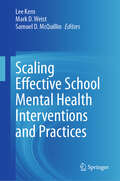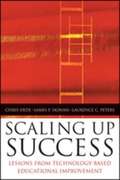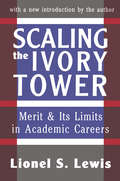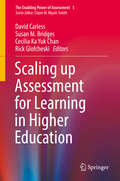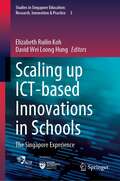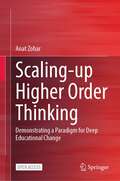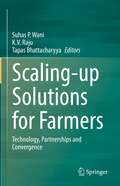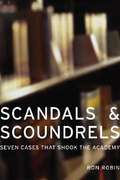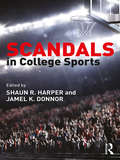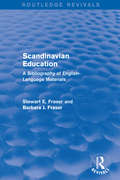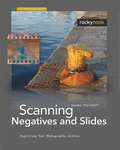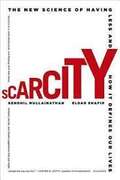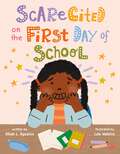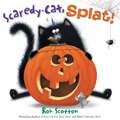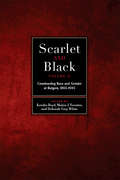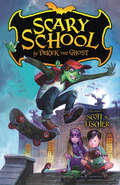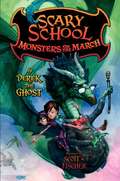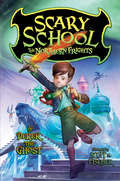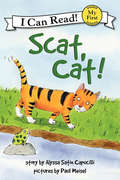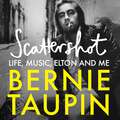- Table View
- List View
Scaling Effective School Mental Health Interventions and Practices
by Mark D. Weist Lee Kern Samuel D. McQuillinThis book describes key practices to bring school mental health programs to scale in a sustainable and effective manner. It emphasizes practices that facilitate the organization and delivery of evidence-based mental health interventions in schools. The volume addresses systems issues and practices that lay the groundwork for creating sustainable school mental health programs. It explores important considerations at the school, district, and state levels; tiered intervention as a framework to support school mental health; preparing the workforce; resource utilization and assuring cultural responsiveness and equity for under-served groups of students. In addition, the book focuses on recent and emerging evidence-based practices for practicably scaling school mental health in schools. Chapters examine systematic screening, followed by specific interventions, including just-in-time training and single session interventions. The book concludes with a focus on ways to address systemic barriers to school mental health, such as addressing the mental health of immigrants. Key areas of coverage include: Communities of practice at different levels of scale (e.g., school building, national). Resource mapping across schools and communities. Screening to match student needs with interventions. Systemic issues in service delivery. Scaling Effective School Mental Health Interventions and Practices is a must-have resource for practitioners, clinicians, and mental health therapists as well as researchers, professors, and graduate students across such interrelated disciplines as school, clinical, and counseling psychology, educational policy and government relations, social work, public health; family leaders and advocates, and medicine and allied health professions (e.g., psychiatry, primary care, nursing, speech and occupational therapy)
Scaling Up Success
by Ellen Condliffe Lagemann Chris Dede James P. Honan Laurence C. PetersDrawing from the information presented at conference sponsored by the Harvard Graduate School of Education and the Mid-Atlantic Regional Technology in Education Consortium, leading educators, researchers, and policymakers, Scaling Up Success translate, theory into practice and provide, a hands-on resource that clearly describes different models for "scaling up" success. This important resource is filled with illustrative examples of best practices that are grounded in real-life case studies of technology-based educational innovation¾from networking a failing school district in New Jersey to using computer visualization to teach scientific inquiry in Chicago. Scaling Up Success show how the lessons learned from technology-based educational innovation can be applied to other school improvement efforts.
Scaling the Ivory Tower: Merit and Its Limits in Academic Careers
by Lionel S. LewisFollowing in the tradition of Thorstein Veblen's Higher Learning in America, Lionel S. Lewis has amassed solid evidence to support his conclusions about what leads to success in Scaling the Ivory Tower. As background to his consideration of academic freedom, sexism, merit, tenure, and other such highly charged subjects, Lewis examines the attitudes of those in universities toward academic qualification. The modern rule of thumb has become publish or perish. According to Lewis, however, research and publication may not be such prime considerations after all.Two thought-provoking chapters are devoted to an examination of letters of recommendation as important factors in hiring and promoting in the academic world. Lewis also scrutinizes academic freedom cases from the archives of the American Association of University Professors. Other intriguing issues examined by Lewis are: how spouses and significant others factor into whether or not a professor gets a promotion; a typical day in the life, both academic and personal, of a professor; how the celebrity syndrome has spread to campus; discrimination against women; and bureaucracy as a contributing factor to campus unrest.In the new introduction, Lewis affirms that the most apparent changes in higher education since Scaling the Ivory Tower was initially published have actually made the campus less meritocratic, and less a place where quality academic work is recognized and rewarded. One contributing factor is the necessity to consider age, gender, ethnicity, and race in personnel decisions. Because many on campus are convinced that academic life can only be improved when the demographics of faculty reflect those in the larger society, departments are routinely expected to explain why they did not fill an opening with someone from an underrepresented group. While showing some irreverence toward academia, Scaling the Ivory Tower should also provoke sober consideration of where our colleges and universities are headed. This is a significant volume for university administrators, academics, and graduate students.
Scaling up Assessment for Learning in Higher Education
by David Carless Susan M. Bridges Cecilia Ka Yuk Chan Rick GlofcheskiA critical issue in higher education is the effective implementation of assessment with the core purpose of promoting productive student learning. This edited collection provides a state-of-the-art discussion of recent, cutting-edge work into assessment for learning in higher education. It introduces a new theme of scaling up, which will be welcomed by theorists, researchers, curriculum leaders and university teachers, and showcases the work of leading figures from Australia, England, continental Europe and Hong Kong. The work illuminates four key elements: (1) Enabling assessment chan≥ (2) Assessment for learning strategies and implementation; (3) Feedback for learning; (4) Using technology to facilitate assessment for learning. Solidly research-based and carrying important implications for enhanced practice in assessment for learning at the university level, it is a must read for academic developers, researchers, university teachers, academic leaders and all those interested in assessment matters.
Scaling up ICT-based Innovations in Schools: The Singapore Experience (Studies in Singapore Education: Research, Innovation & Practice #3)
by Elizabeth Ruilin Koh David Wei Loong HungThis collected book is about the eduLab projects, an initiative with focus on Scaling Change through Apprenticising and Ecological Leadership, designed to surface and spread ground-up information and communication technology-based pedagogical innovations. It presents the goals and rationale behind eduLab, an overview of the research projects conducted by its principal investigators during its funding tenure, as well as synthesizing thoughts on the entire endeavor. This book not only marks the achievements of the eduLab programme but also serves as inspiration for future projects. It presents Singapore education in action – a continually evolving and adapting education system that delivers a system well known for its high quality as much as it is forward-looking.
Scaling-up Higher Order Thinking: Demonstrating a Paradigm for Deep Educational Change
by Anat ZoharThis open access book addresses the evasive problem of why truly effective educational innovation on a wide scale is so difficult to achieve, and what leaders may do about this. Examining the case of system-wide reform processes centering on teaching a thinking-rich curriculum, it discusses general issues pertaining to implementing deep, large-scale changes in the core of learning and instruction. The book emphasizes challenges related to professional development, assessment, achievement gaps, and the tension between knowledge and skills in 21st century curricula. It summarizes insights the author has gained from approximately 25 years of engaging with these topics both as an academic and as a practitioner who led a national change process.With a Forward by David Perkins
Scaling-up Solutions for Farmers: Technology, Partnerships and Convergence
by Tapas Bhattacharyya K. V. Raju Suhas P. WaniThis book provides a unique account of cross-sectoral innovations through efficient partnerships based on the hands-on experience of internationally renowned contributors specialised in the field of Science of Delivery. The challenges and lessons learned from large development initiatives based in Asia, and from the work undertaken by international research institutions, such as the FAO, are brought together in this book to benefit development agencies, policy makers, corporates, post graduate students, farmers’ organizations, and those involved in supplying agricultural inputs and/or buying agricultural produce, particularly in developing countries within Asia and Africa. Through a number of case studies the book describes how the consortium approach of capacity building for equitable and efficient benefits, collective action, and convergence, will benefit millions of small farm-holders in different regions of Asia
Scamper: Creative Games and Activities for Imagination Development (Combined ed., Grades 2-8)
by Bob EberleThis new edition of Scamper combines the activities formerly found in the original title plus Scamper On into one cohesive and user-friendly volume of the classic thinking skills games. Your students will develop their imaginations through a series of guided activities in which they imagine different events or things. Scamper is a creative thinking technique that helps students imagine the world in a completely new way. In this book, students are challenged to think creatively and develop their powers of imagination. Whether they think up new animals by combining characteristics of two very different animals, or try to imagine the perfect meal, students are motivated to create new ideas.Each activity features a complete teacher script to be read aloud to students as they participate in a Scamper exercise. Teachers are led through each exercise with step-by-step cues on when to wait, how to modify the activity for more or less participation, and how to extend the activity.Each of the imagination activities is designed to fit easily within class time and has been tested by an experienced educator. Ideal for helping students develop imagination for writing classes, the activities are also useful for any class where students must think creatively. By allowing students the freedom to explore their imaginations, they are able to better develop their creativity skills.Grades 2-8
Scan Artist: How Evelyn Wood Convinced the World That Speed-Reading Worked
by Marcia BiedermanThe best-known educator of the 20th century was a scammer in cashmere. "The most famous reading teacher in the world," as television hosts introduced her, Evelyn Wood had little classroom experience, no degrees in reading instruction, and a background that included cooperation with the Third Reich. Nevertheless, a nation spooked by Sputnik and panicked by paperwork eagerly embraced her promises of a speed-reading revolution. Journalists, lawmakers and two US presidents lent credibility to Wood's claims of turbocharging reading speeds through a method once compared to the miracle at Lourdes. A royal-born Wood grad said she'd polished off Moby Dick in three hours; a senator swore he finished one book per lunchtime. Fudging test results, and squelching critics, Wood founded a company that enrolled half a million. The course's popularity endured even as science proved that her system taught only skimming, with disastrous effects on comprehension. As apps and online courses attempt to spark a speed-reading revival, this engaging look at Wood's rise from missionary to marketer exposes the pitfalls of wishful thinking.
Scandal: A Private Novel
by Kate BrianAfter her harrowing kidnapping, Reed returns to Easton to find the worst thing she can think of—Billings has been torn down. Finally, after years of controversy, the school’s wealthiest female alumni have been overruled, and the historical dorm is gone from Easton Academy. How will Reed and the rest of the Billings Girls handle it? Will they still be as powerful, as popular, and as wicked—with literally no ground to stand on?
Scandals and Scoundrels: Seven Cases That Shook the Academy
by Ron RobinRon Robin takes an intriguing look at the shifting nature of academic and public discourse in this incisive consideration of recent academic scandals. Scandals and Scoundrels makes the case that, contrary to popular imagery, we're not living in particularly deviant times and there is no fundamental flaw permeating a decadent academy. Instead, Robin argues, latter-day scandals are media events, tailored for the melodramatic and sensationalist formats of mass mediation.
Scandals in College Sports: Legal, Ethical, And Policy Case Studies
by Shaun R. Harper Jamel K. DonnorThis timely book highlights the impact that sports have on institutions of higher education and guides college leaders and educators in informed discussions of policy and practice. Scandals in College Sports includes 21 classic and contemporary case studies and ethical dilemmas showcasing challenges that threatened the integrity and credibility of intercollegiate sports programs at a range of institutional types across the country. Cases cover NCAA policy violations and ethical dilemmas involving student-athletes, coaches, and other stakeholders, including scandals of academic misconduct, illegal recruiting practices, sexual assault, inappropriate sexual relationships, hazing, concussions, and point shaving. Each chapter author explores the details of the specific case, presents the dilemma in a broader sociocultural context, and ultimately offers an alternative ending to help guide future practice.
Scandinavian Education: A Bibliography of english- language materials (Routledge Revivals)
by Stewart. E Fraser Barbara. J FraserThis title was first published in 1973. Education in the Scandinavian countries has commanded significant international attention over the past decade. Initiatives taken to promote comprehensive educational planning, the democratization of educational opportunity, curricular and structural renewal, university reform, innovation in adult education, and an international perspective in instruction at every level are but some of the developments that educators throughout the world have followed with interest. Those interested in education in the Nordic societies, Stewart and Barbara Fraser's annotated bibliography of English-language materials on Scandinavian education will provide an important new reservoir of source materials. The bibliography is conveniently cross-referenced and organized into specialized educational categories
Scanning Negatives and Slides: Digitizing Your Photographic Archive, 2nd Edition
by Sascha Steinhoff<p>Many photographers have either moved into digital photography exclusively or use both analog and digital media in their work. In either case, there is sure to be an archive of slides and negatives that cannot be directly integrated into the new digital workflow, nor can it be archived in a digital format. Increasingly, photographers are trying to bridge this gap with the use of high-performance film scanners. <br/><br/>\nIn this 2nd edition, you will learn how to achieve the best possible digital image from a negative or a slide, and how to build a workflow to make this process efficient, repeatable, and reliable. The author uses Nikon's film scanners, but all steps can easily be accomplished while using a different scanner. The most common software tools for scanning (SilverFast, VueScan, NikonScan) are not only covered extensively in the book, but trial versions are also provided on a DVD, which also contains other useful tools for image editing, as well as numerous sample scans.</p>
Scarcity: The New Science Of Having Less And How It Defines Our Lives
by Sendhil Mullainathan Eldar ShafirIn the blockbuster tradition of Freakonomics, a Harvard economist and a Princeton psychology professor team up to offer a surprising and empowering new way to look at everyday life, presenting a paradigm-challenging examination of how scarcity - and our flawed responses to it - shapes our lives, our society, and our culture. Why do successful people get things done at the last minute? Why does poverty persist? Why do organizations get stuck firefighting? Why do the lonely find it hard to make friends? These questions seem unconnected, yet Sendhil Mullainathan and Eldar Shafir show that they are all are examples of a mindset produced by scarcity. Drawing on cutting-edge research from behavioral science and economics, Mullainathan and Shafir show that scarcity creates a similar psychology for everyone struggling to manage with less than they need. Busy people fail to manage their time efficiently for the same reasons the poor and those maxed out on credit cards fail to manage their money. The dynamics of scarcity reveal why dieters find it hard to resist temptation, why students and busy executives mismanage their time, and why sugarcane farmers are smarter after harvest than before. Once we start thinking in terms of scarcity and the strategies it imposes, the problems of modern life come into sharper focus.
Scarcity: Why Having Too Little Means So Much
by Sendhil Mullainathan Eldar ShafirA surprising and intriguing examination of how scarcity-and our flawed responses to it-shapes our lives, our society, and our culture. Why do successful people get things done at the last minute? Why does poverty persist? Why do organizations get stuck firefighting? Why do the lonely find it hard to make friends? These questions seem unconnected, yet Sendhil Mullainathan and Eldar Shafir show that they are all examples of a mind-set produced by scarcity. Drawing on cutting-edge research from behavioral science and economics, Mullainathan and Shafir show that scarcity creates a similar psychology for everyone struggling to manage with less than they need. Busy people fail to manage their time efficiently for the same reasons the poor and those maxed out on credit cards fail to manage their money. The dynamics of scarcity reveal why dieters find it hard to resist temptation, why students and busy executives mismanage their time, and why sugarcane farmers are smarter after harvest than before. Once we start thinking in terms of scarcity and the strategies it imposes, the problems of modern life come into sharper focus. Mullainathan and Shafir discuss how scarcity affects our daily lives, recounting anecdotes of their own foibles and making surprising connections that bring this research alive. Their book provides a new way of understanding why the poor stay poor and the busy stay busy, and it reveals not only how scarcity leads us astray but also how individuals and organizations can better manage scarcity for greater satisfaction and success.
Scarecited on the First Day of School
by Alliah L. AgostiniFor fans of School’s First Day of School, this is a picture book about a young girl who is feeling mixed emotions about her first day of school.Some feelings are so big, one word just doesn’t cut it. It’s the first day of school for Afua! There’s no one word to name her feelings. Is she scared? Excited? Oh wait, she’s scarecited! Her own combination of both. Why should she have to choose?Scarecited on the First Day of School is a charming picture book that reminds us all that having the courage to be our authentic self is always just enough, and you can feel more than one big emotion at the same time. But if there isn’t one word to describe those feelings . . . there’s beauty in making it yourself.
Scaredy-Cat, Splat! (Splat the Cat)
by Rob ScottonIt's Halloween and Splat is determined to be the scariest cat in the class. Unfortunately he's just too much of a scaredy-cat. He's afraid of a little spider, and everyone says his costume looks more silly than scary. And when the teacher tells a ghost story in the dark, Splat gets so frightened that he tips over his jack-o-lantern. But when the lights go back on, the entire class is scared silly by a small, black furry creature with a big pumpkin head. Whoooo could it be?
Scarlet and Black, Volume Three: Making Black Lives Matter at Rutgers, 1945-2020
by Edward White Joseph Williams Beatrice J. Adams Tracey Johnson Pamela N. Walker Meagan Wierda Roberto C. Orozco Carie Rael Brooke A. Thomas Ian Gavigan Kaisha Esty Whitney Fields Jesse Bayker Kenneth Morrissey Joseph Kaplan Lynda DexheimerThe 250th anniversary of the founding of Rutgers University is a perfect moment for the Rutgers community to reconcile its past, and acknowledge its role in the enslavement and debasement of African Americans and the disfranchisement and elimination of Native American people and culture. Scarlet and Black, Volume Three, concludes this groundbreaking documentation of the history of Rutgers’s connection to slavery, which was neither casual nor accidental—nor unusual. Like most early American colleges, Rutgers depended on slaves to build its campuses and serve its students and faculty; it depended on the sale of black people to fund its very existence. This final of three volumes concludes the work of the Committee on Enslaved and Disenfranchised Population in Rutgers History. This latest volume includes essays about Black and Puerto Rican students' experiences; the development of the Black Unity League; the Conklin Hall takeover; the divestment movement against South African apartheid; anti-racism struggles during the 1990s; and the Don Imus controversy and the 2007 Scarlet Knights women's basketball team. To learn more about the work of the Committee on Enslaved and Disenfranchised Population in Rutgers History, visit the project's website at http://scarletandblack.rutgers.edu.
Scarlet and Black, Volume Two: Constructing Race and Gender at Rutgers, 1865-1945
by Joseph Williams Beatrice J. Adams Shauni Armstead Miya Carey Tracey Johnson Brenann Sutter Pamela N. Walker Meagan Wierda Caitlin Reed Wiesner Shari Cunningham Eri Kitada Jerrad P PacatteThe 250th anniversary of the founding of Rutgers University is a perfect moment for the Rutgers community to reconcile its past, and acknowledge its role in the enslavement and debasement of African Americans and the disfranchisement and elimination of Native American people and culture. Scarlet and Black, Volume 2, continues to document the history of Rutgers’s connection to slavery, which was neither casual nor accidental—nor unusual. Like most early American colleges, Rutgers depended on slaves to build its campuses and serve its students and faculty; it depended on the sale of black people to fund its very existence. This second of a planned three volumes continues the work of the Committee on Enslaved and Disenfranchised Population in Rutgers History. This latest volume includes: an introduction to the period studied (from the end of the Civil War through WWII) by Deborah Gray White; a study of the first black students at Rutgers and New Brunswick Theological Seminary; an analysis of African-American life in the City of New Brunswick during the period; and profiles of the earliest black women to matriculate at Douglass College. To learn more about the work of the Committee on Enslaved and Disenfranchised Population in Rutgers History, visit the project's website at http://scarletandblack.rutgers.edu
Scary School
by Scott M. Fischer Derek The GhostYou think your school's scary? Get a load of these teachers: Ms. Fang, an 850-year-old vampire Dr. Dragonbreath, who just might eat you before recess Mr. Snakeskin-science class is so much more fun when it's taught by someone who's half zombie Mrs. T-break the rules and spend your detention with a hungry Tyrannosaurus rex! Plus Gargoyles, goblins, and Frankenstein's monster on the loose The world's most frighteningly delicious school lunch And The narrator's an eleven-year-old ghost! Join Charles "New Kid" Nukid as he makes some very Scary friends-including Petunia, Johnny, and Peter the Wolf-and figures out that Scary School can be just as funny as it is spooky!
Scary School #2: Monsters on the March
by Scott M. Fischer Derek The GhostAs winners of last year's Ghoul Games, the students of Scary School are off to Monster Forest. School may be scary, but the forest has a few frights of its own, including: Bearodactyls-so terrifying we can't even show you pictures of them Princess Zogette, the Monster King's toad-faced daughter, who falls for Charles Nukid . . . hard Captain Pigbeard, fearsome leader of the Monster-Pirates and Princess Zogette's fiancÉ (well, former fiancÉ, thanks to Charles) And when Zogette follows Charles to Scary School, the Monster King and Captain Pigbeard raise their armies and chase after her. But the monsters have no idea who-or what-they're dealing with. In this clever, funny sequel to the frighteningly hilarious Scary School, Charles, Penny Possum, Dr. Dragonbreath, and all the students and teachers prove that scary monsters are no match for Scary School!
Scary School #3: The Northern Frights
by Derek The GhostCharles Nukid and his friends--including new student Lattie, a tough ninja girl--take on their biggest challenge yet in this frighteningly funny addition to the Scary School series. When theyre chosen to attend Scream Academy as exchange students, theyll have to face: Rolf Meltington--the principal of Scream Academy and the abominable snowmanPolter-bears--part poltergeist, part polar bear . . . totally frighteningThe Headless Horseman--dont lose your head in his classBut theres something even scarier than going to school with yetis, ogres, and trolls: the Ice Dragon. As an ancient prophecy comes to pass, Charles finds himself destined to battle the monstrous Ice Dragon in order to save both Scream Academy and Scary School from destruction.
Scat, Cat! (My First I Can Read)
by Alyssa Satin CapucilliA small striped cat finds his way homeNo one wants the small striped cat who is lost. “Scat, cat!” says the dog, the bird, the barber, the baker, the bus driver, the duck, the frog, the goose, the owl, the bat, and even the skunk.So the cat walks and walks until he finds a little house where there is a little boy that does not say, “Scat, cat!” In an ending twist, the cat discovers he is home. Young readers will learn the names of animals and occupations as well as useful vocabulary in this sweet and simple text.This My First I Can Read Book is perfect for shared reading with toddlers and very young children. Basic language, word repetition, and whimsical illustrations make this book just right for the emergent reader.
Scattershot: Life, Music, Elton and Me
by Bernie Taupin'This is the most glorious of books. I am besotted by the life I never knew he had.' -Elton John'Orgasmic. Every page of Scattershot is a delight, a joy, a name-dropper fan's delight. Divine. I couldn't put it down.' -Pete Townshend'In Bernie Taupin's miraculous memoir Scattershot you'll meet legends, cowboys, geniuses, unforgettable faces in the night, shady purveyors of outrageous fortune, warriors of the heart, and most of all, Taupin himself. Hilarious and so emotionally true, Scattershot is like a letter from a cherished friend. You'll want to keep it close, so you can read it again and again.' -Cameron Crowe'Touching. Charming. Humble. Witty. And exquisitely written. Taupin's words need no musical accompaniment. They sing with a poets voice.' -Gary Oldman'Eloquent and inspiring, Scattershot is a freewheeling memoir that is as warm and evocative as Bernie Taupin's most memorable lyrics. A born storyteller, Taupin gives us the life of an artist whose outlook was shaped by a rare but fascinating blend of lifelong innocence and endless intellectual curiosity.' -Robert Hilburn, author of Johnny Cash: The Life"I loved writing, I loved chronicling life and every moment I was cogent, sober, or blitzed, I was forever feeding off my surroundings, making copious notes as ammunition for future compositions. . . . The thing is good, bad or indifferent I never stopped writing, it was as addictive as any drug."This is the memoir music fans have been waiting for. Half of one of the greatest creative partnerships in popular music, Bernie Taupin is the man who wrote the lyrics for Elton John, who conceived the ideas that spawned countless hits, and sold millions and millions of records. Together, they were a duo, a unit, an immovable object. Their extraordinary, half-century-and-counting creative relationship has been chronicled in biopics (like 2019's Rocketman) and even John's own autobiography, Me. But Taupin, a famously private person, has kept his own account of their adventures close to his chest, until now.Written with honesty and candour, Scatterhot allows the reader to witness events unfolding from Taupin's singular perspective, sometimes front and center, sometimes from the edge, yet always described vibrantly, with an infectious energy that only a vivid songwriter's prose could offer. From his childhood in the East Midlands of England whose imagination was sparked and forever informed by the distinctly American mythopoetics of country music and cowboys, to the glittering, star-studded fishbowl of '70s and '80s Beverly Hills, Scattershot is simultaneously a Tom Jones-like picaresque journey across a landscape of unforgettable characters, as well as a striking, first-hand account of a creative era like no other and one man's experience at the core of it.An exciting, multi-decade whirlwind, Scattershot whizzes around the world as we ride shotgun with Bernie on his extraordinary life. We visit New York with him and Elton on the cusp of global fame. We spend time with him in Australia almost in residency at an infamous rock 'n' roll hotel in an endless blizzard of drugs. And we spend late, late night hours with John Lennon, with Bob Marley, and hanging with Frank Sinatra. And beyond the world of popular music, we witness memorable encounters with writers like Graham Greene, painters like Andy Warhol and Salvador Dali, and scores of notable misfits, miscreants, eccentrics, and geniuses, known and unknown. Even if they're not famous in their own right, they are stars on the page, and we discover how they inspired the indelible lyrics to songs such as "Tiny Dancer," "Candle in the Wind," "Bennie and The Jets," and so many more.Unique and utterly compelling, Scattershot will transport the reader across the decades and around the globe, along the way meeting some of the greatest creative minds of the 20th century, and in
